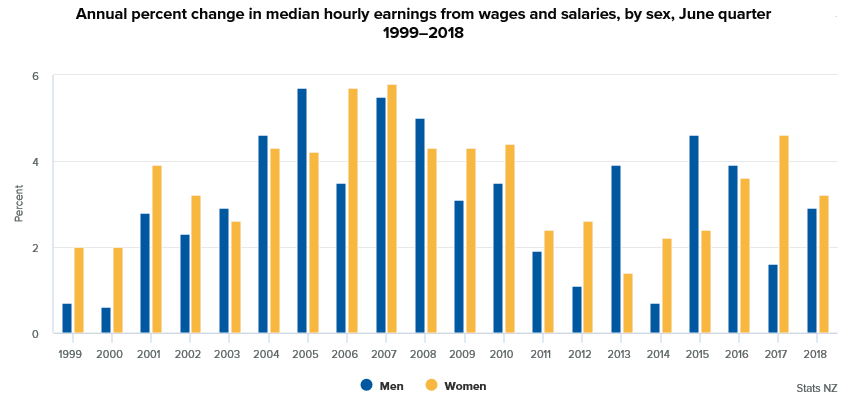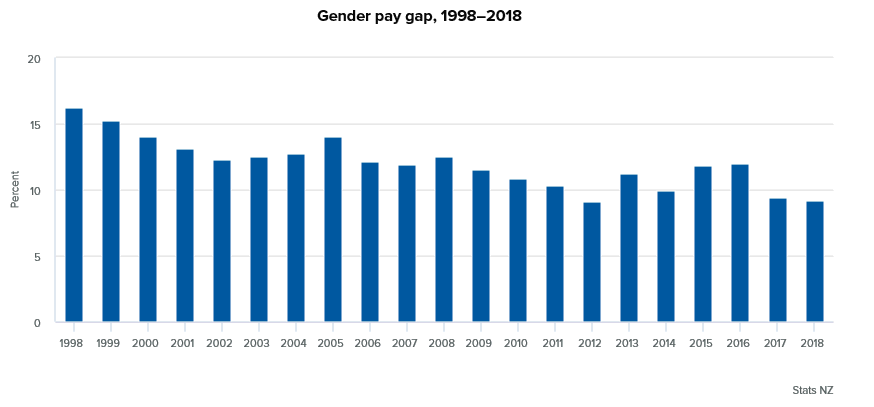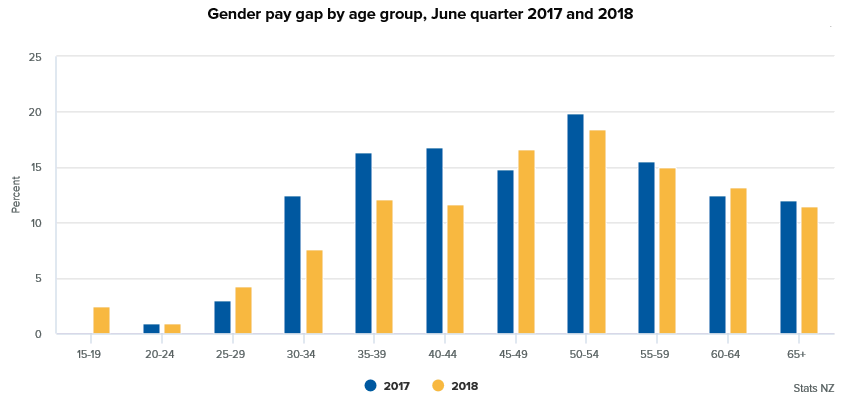Gender pay gap is second-smallest
Gender pay gap is second-smallest – Media release
15 August 2018
The gender pay gap was 9.2 percent in the June 2018 quarter, Stats NZ said today.
This is the second-smallest gap since the series began 20 years ago. In comparison, the gender pay gap was 9.1 percent in 2012 (the lowest on record) and 9.4 percent last year.
The gender pay gap shows the difference in median hourly earnings for men and women. For the second year in a row, the gap reflected that median hourly earnings for women, from wages and salaries, increased faster than for men, up 3.2 and 2.9 percent, respectively.

“Since 1998, the gender pay gap has been trending down. It’s fallen more than 40 percent,” labour market manager Sean Broughton said.
“However, while the gap has closed over the past 20 years, on average women are still paid less for an hour’s work than men.”

“The gender pay gap is a useful measure when trying to understand differences in pay between men and women, due to its simplicity. But this measure is limited. It doesn’t account for men and women doing different jobs or working different hours. It also doesn’t account for personal characteristics that can influence pay, such as qualifications and age,” Mr Broughton said.
Gender gap varies with age and work status
The gender pay gap is smaller for people aged under 30 years. In 2018, for those aged 15–19 years the gap was 2.4 percent, for 20–24-year-olds it was 0.9 percent, and for workers aged 25–29 years the gap was 4.2 percent. The largest gap was for people aged 50–54 years (18.4 percent).

The gender pay gap is smaller for full-time than part-time workers. In 2018, the gap for full-time workers was 7.9 percent. For part-time workers, there was a ‘negative’ gap of 11.1 percent. This means that, on average, women in part-time employment were paid more for an hour’s work than men.
Hourly earnings up 2.9 percent
In the year to the June 2018 quarter, median hourly earnings from wages and salaries were up 71 cents (2.9 percent), to reach $25.00.
Median hourly earnings increased in these
occupation groups:
• community and personal services
– up 12.2 percent
• machinery operators and drivers
– 7.1 percent
• sales – 5.6 percent
• clerical
and administration – 3.9 percent.
Pay increases for personal care assistants and increases in the proportion of people employed as personal care assistants both contributed to the increase for the community and personal service workers.
“The pay increase for community and personal service workers coincided with the introduction of the Care and Support Workers (Pay Equity) Settlement Act 2017 last year, and the rise in the minimum wage to $16.50 in April 2018,” Mr Broughton said.
Industries with increased median hourly earnings for the year included:
• art,
recreation, and other services – up 8.0
percent
• education and training – 4.5
percent
• manufacturing – 4.2 percent
• retail
trade and accommodation – 3.7 percent.
Art, recreation, and other services includes museums, performing arts, and automotive services.
Tertiary education was the key contributor to the increase for the education and training industry.
Weekly earnings up 4.0 percent
Median weekly earnings from wages and salaries increased $38 (4.0 percent), to reach $997 in the year to the June 2018 quarter. For women, the increase was $33 (4.0 percent), to reach $863 a week, while for men it was $32 (2.9 percent), to reach $1,140.
More full-time workers for the year (up 79,000) – 36,900 more men and 42,100 more women – contributed to the increase in median weekly earnings from wages and salaries.
Video
View our Labour market statistics (income) videos:
Denise McGregor, Deputy Government Statistician, talks about the gender pay gap
Renee Graham, Chief Executive of the Ministry for Women, discusses the gender pay on YouTube from 11am.
Ends
For more
information about these statistics:
• Visit Labour market statistics (income): June 2018
quarter


 Netsafe: Netsafe And Chorus Power Up Online Safety For Older Adults
Netsafe: Netsafe And Chorus Power Up Online Safety For Older Adults RBNZ: 10 Cent Coin With King Charles III Image Now In Production
RBNZ: 10 Cent Coin With King Charles III Image Now In Production NZALPA: Safety Improves From AKL Incident Learnings
NZALPA: Safety Improves From AKL Incident Learnings NIWA: Antarctic Footprint Clean-up Challenges - How A Remote Antarctic Base Clean-up Protected One Of Earth’s Clearest Lakes
NIWA: Antarctic Footprint Clean-up Challenges - How A Remote Antarctic Base Clean-up Protected One Of Earth’s Clearest Lakes Hugh Grant: Can A Meme Coin Become A Real Payment Solution?
Hugh Grant: Can A Meme Coin Become A Real Payment Solution? Imported Motor Vehicle Industry Association: EV Battery Fires Expose New Zealand Regulatory Gap
Imported Motor Vehicle Industry Association: EV Battery Fires Expose New Zealand Regulatory Gap 


